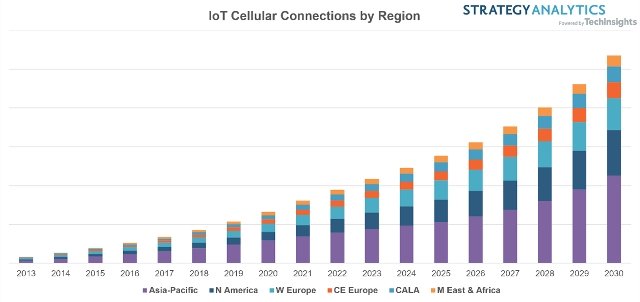IoT Cellular connections are forecast to achieve a compound annual growth rate (CAGR) of 14 percent during 2022-2030, Strategy Analytics said in its latest report.
 North America and Asia-Pacific are expected to achieve the highest compound annual growth rate (CAGR) of 16 percent and 14 percent respectively.
North America and Asia-Pacific are expected to achieve the highest compound annual growth rate (CAGR) of 16 percent and 14 percent respectively.
5G will be making strong in-roads replacing 4G connections. 4G will have 49 percent of IoT connections in 2030 as compared with 71 percent of connections in 2022.
“We expect a decline in IoT cellular connections in 2022 due to Covid-19 lockdown in China, chip shortage / supply chain disruption and geopolitical conflicts,” Waseem Haider, Principal Analyst, Enterprise IoT at Strategy Analytics, said. The overall IoT cellular connections will grow at 14 percent throughout the forecast period.
The outlook for the IoT cellular connections is clear: 4G will continue to dominate overall, driven by 2G replacements, especially in China, but also elsewhere. 3G phases out with most connections moving to 4G. 5G will reach 47 percent of the connections mix by 2030, while 4G will remain the dominant technology at 49 percent.
The adoption of 5G will happen in different stages, with eMBB reaching mass adoption first, uRLLC gaining traction soon afterward, and mMTC showing the longest tail. Growth of 5G in IoT connections will be determined by the availability of 5G chipsets, the speed and coverage of 5G network, and as well as the evolution of regulations.
The engine for driving 5G forward for fast growth and adoption is its radio access technology — New Radio (NR). One recent example is NR support for reduced capability (RedCap) devices which can facilitate the expansion of the NR device ecosystem to cater to use cases include wearables, industrial sensors, and video surveillance, as these are not yet best served by the current NR specifications.





